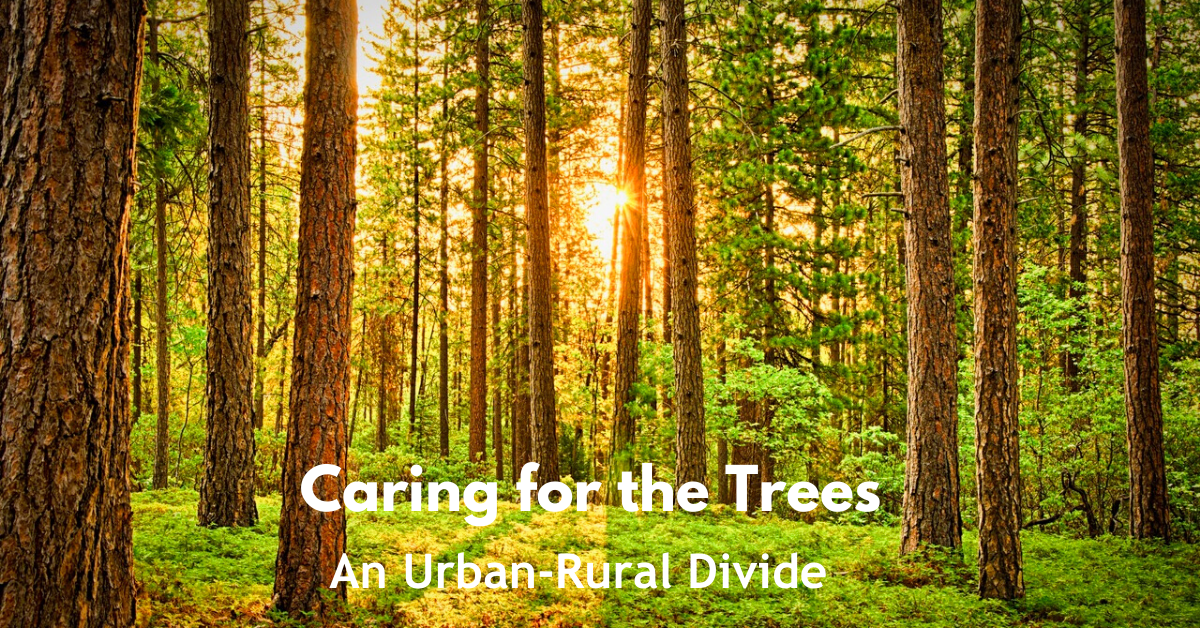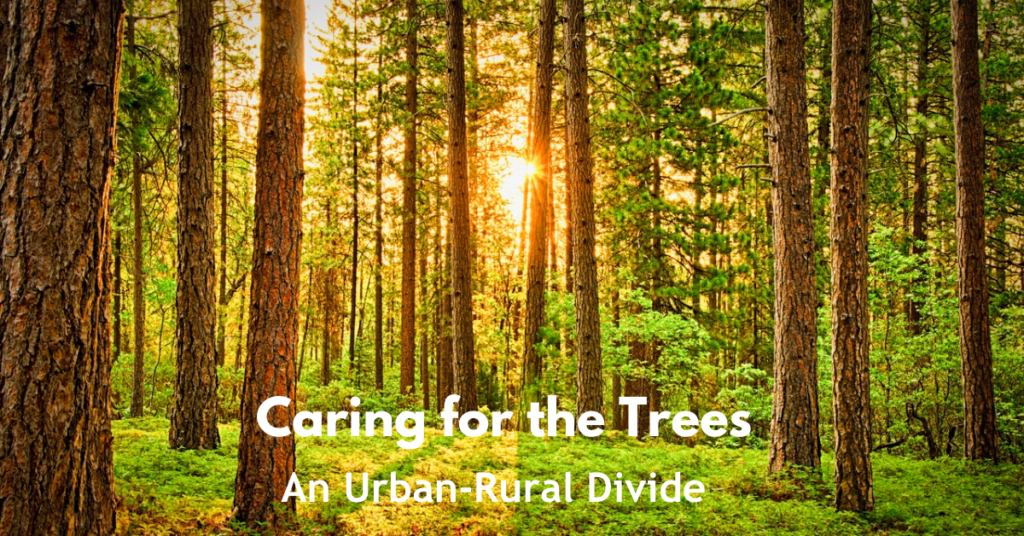Caring for the Trees: An Urban-Rural Divide

When it comes to caring for God’s creation with regard to our nation’s wooded lands, there is often a disconnect between rural and urban areas. As a pastor who has been serving small rural congregations in the United Church of Christ since the 1970s, let me explain how I came to this perspective. I currently serve three congregations that stretch along the Canadian border in Northern Minnesota by the Rainy River between Rainy Lake and Lake of the Woods. Along with fishing tourism, the timber industry is an important part of our economy along with some paper or packaging businesses.
Timber in this area is based on soft wood. The trees are quick growing and short lived relative to other trees. Some reach maturity in 40-100 years and go downhill quickly after that. Rather than being made into lumber for building construction, they truly are best used when ground up for paper, cardboard, or pressed wood production. A lot of the trees from around here are made into cardboard boxes to be used for shipping containers like that brown box with the smile on it.
The amount of trees that are processed around here is incredible. They are cut down with machines that may use a chainsaw on the end of a long arm or a mechanical clippers that will cut the tree off near the ground like a hand weed trimmer. The top is cut off and depending on the order they can be cut up into logs or loaded intact on trucks to be hauled to a plant for processing. Imagine a semi loaded lengthwise with 15 to 20 whole trees going down the highway. Then, they are placed in piles until they can be ground up into chips and put into at least a three-story pile, to be loaded on a conveyor belt and made into cardboard boxes. It is nothing for a forty-acre patch of land to be clear cut of the particular type of trees wanted.
While this may sound destructive and wasteful, it isn’t. The modern timber industry has turned cutting these types into a form of farming not unlike growing any other row crop, like corn, soybean or vegetables. They have done this because it is the most efficient way to produce the products that modern life demands such as cardboard boxes to ship online orders around the country. They are striving for a tree production that produces quality trees of the same age, size, and quality that can easily be cut, shipped, and processed because they are all the same size in length and width of trunk. Also, they can easily be replanted, and in forty or so years, they will again be mature enough to cut and repeat the process.
By cutting small blocks out of a bigger stand of trees, the forest can be managed to continue to produce trees in a process that will guarantee a supply of mature trees for the foreseeable future. Thus, the industry is sustainable, with a standardized product that continues to meet the demand, while still providing forest lands for recreation, and protecting the environment. Because the land doesn’t need to be worked, there is little danger of unnatural runoff or pollution. Also, these new growth areas provide habitat for many different animals like deer and birds.
But let’s not forget the demand for these industry products come from people sitting at home and ordering things over their “smart devices” and expecting them shipped to their front door. While the industry is located in far northern Minnesota six hours from the Twin Cities, it goes on across the entire nation. The demand comes from people living in urban and suburban areas that want products delivered in a car.
A similar process is used to produce the “Engineered Lumber” used in many new homes to replace the size logs and lumber we use to produce in this country from old growth trees. Now, often the limbs and what used to be waste from cutting down trees along with the trees themselves are ground up and mixed with chemical resins and pressed into boards that can be put together to form tresses and beams large enough that they can make possible the “Open Concepts” of modern homes. In my last parish, we built a new church and the sanctuary design was possible only because of this kind of construction. Thus, like in online shopping, it is the construction of new homes in urban areas that is driving the need to cut down trees.
Since trees like maple and oak and some pines grow relatively slow, the demand for hard wood furniture or solid wood veneer means cutting down trees that are not as easily replaced as the ones around here are. While we talk about the deforestation in Africa and South America, we should be talking about the use of wood and timber in this country and how in some suburban areas the spread of housing, roads, and parking are reducing the amount of trees in this country.
The modern timber industry is trying to meet the demand for wood products in environmentally friendly ways. They are doing their job so well that there are fewer and fewer people needed in the industry, which adds to the poverty in areas like this. The cardboard plant here is working at half of its capacity but still the numbers of trees going through it are astounding. We need to talk about these kinds of issues across the divide of rural and urban because we both play a hand in timber production in our country. People in urban areas create the demand and the timber industry is trying to meet the demand in a way that is both good for the bottom line but also for the environment so that the business will go one for many years.
Related News
Can a Small Church Make a Difference on Environmental Justice? Yes!
American anthropologist Margaret Mead once observed, “Never doubt that a small group of...
Read MoreChurch Launches Community Composting Opportunity
Coral Isles Church in Tavernier, Florida recently kicked off a community composting...
Read MorePostcards for the Planet: Engaging Environmental Voters This Election Season
During this election season, the Green Christians at the Coral Gables United Church of...
Read More
